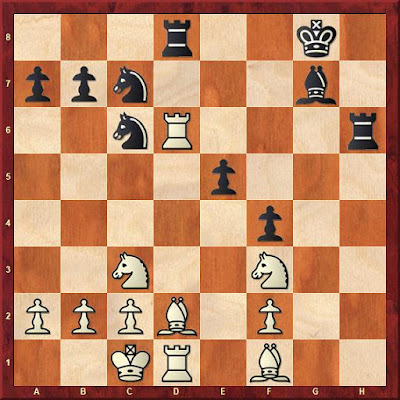From La'Merchav, Feb. 14th, 1958, p. 6, sent to us by a dedicated correspondent:
Ido Aviner - Beno Levi
Sicilian Dragon [B71]
1958?
Source: see above
Annotator: Eliyahu Fasher
1.e4 c5 2.Nf3 d6 3.d4 cxd4 4.Nxd4 Nf6 5.Nc3 g6 6.f4 Nc6 7.Nxc6 bxc6 8.e5 Ng4 Black chose here a variant which, he said, Euwe recommended. Black forces White to open his KS, but paralyzes his own QS. 9.h3 Nh6 10.g4 To prevent Nf5 after White's next move. e6 11.Be3 d5 12.Bg2 Stops the advance of the pawns on Black's QS. (12.g5? Nf5) 12...Be7 13.O-O Ba6 14.Ne2 Self-pinning the N for a long time, but done to keep the f1 square free for the rooks. 14...Qa5 15.b3! Bc5 16.Bxc5 Qxc5+ 17.Kh2 Better than 17. Kh1, as will be clear in the 21st move. 17... Rd8 18. Qd2 Ng8 White's threat was f5 ad then f6. 19. Rf3? Wants to free the N, but doesn't notice Black's next move, which both frees and attacks. 19...h5! 20.Nd4! Keeps the position intact. 20...Qb6 20...hxg4 21.Rc3 with complications. 21. Kg3! c5 21... h4+ 22. Kh2 22. Ne2 Ne7 23. Nc3 Qc7 Of course not 23...d4? 24.Ne4. 24.Re1 Nc6 25. Bf1 hxg4 26. hxg4 Qe7 Threatening mate never hurts! 27.g5 Qb7 28.Rf2 Nd4 29.Bh3 Qb4 30.Na4! Black avoids a queen exchange in an equal position, i.e., trying to win by force. But this costs the paralyzation of the queen. 30...Nb5? 30... Nxc2? White doesn't fear this, due to 31. Rc1 31.c3 Qa3
32.f5! gxf5 33.Bxf5! White exploits the black queen's paralysis to break through. The bishop sacrifice cannot be accepted due to e6 with a crushing attack. But Black manages to find a way to defend by opening a way to his queen. 33...c4 34.Bg4! Keeps the material advantage. 34.g6 Qe7 35.gxf7+ Kf8 and Black wins. 34...Bc8 34...cxb3 35.axb3 Qxb3 36.Qf4 wins; 34...Qe7 35.Ref1, followed by 36.Rf6, 37.g6, etc. 35.Ref1 Qe7 36.Rxf7 Qxf7 37.Rxf7 Kxf7 38.Qf2+ Ke8 Best under the circumstances. 38...Kg8 39.Qf6 Re8 40.Qg6+ Kf8 41.Bh5 and wins. 39.Qf6 Kd7 40.Bxe6+! Kc7 41.Bxc8 Simplest. 41...Rxc8 41... Kxc8 42. Qc6+ Nc7 43. Nc5 etc. 42.Qe7+ Kb8 43.Nc5 Nc7 44.Qd6 and Black resigned (1-0) due to mate in a few moves, e.g. 44...Rcd8 45.Na6+ Kb7 46.Qxc7+ Kxa6 47.Qc6+ Ka5 48. b4#.















































